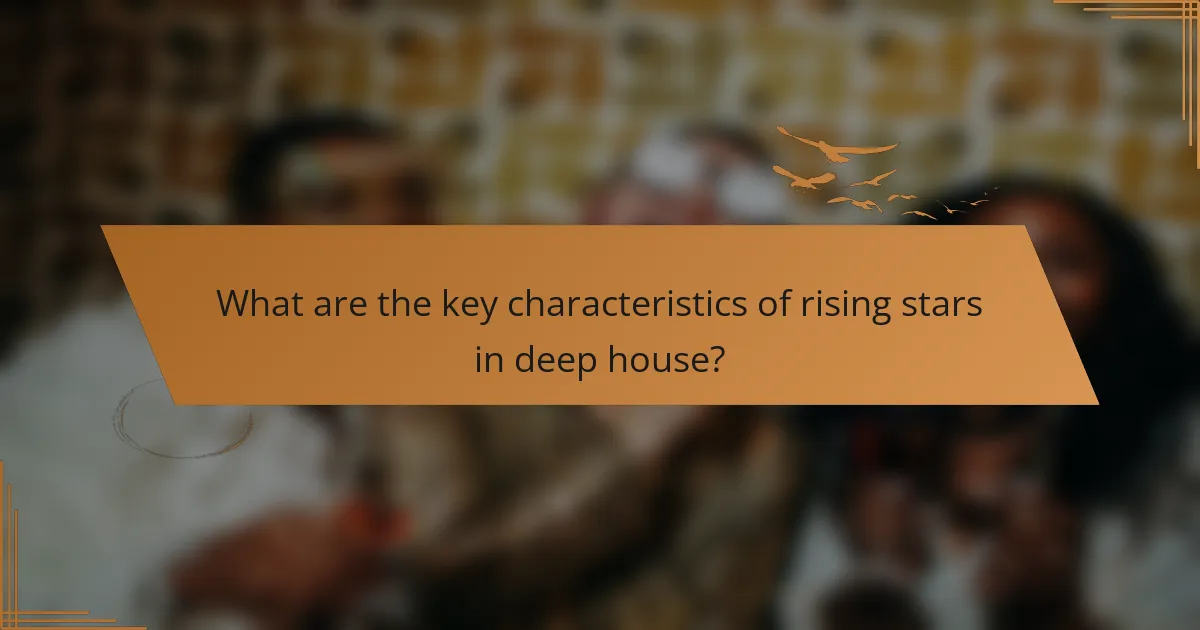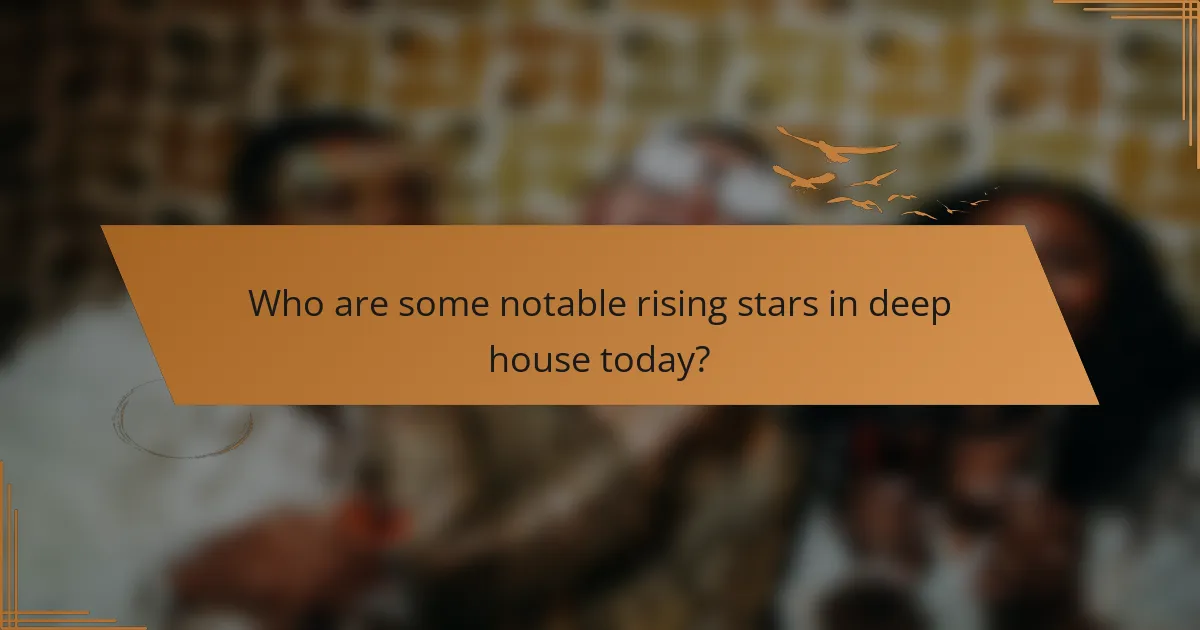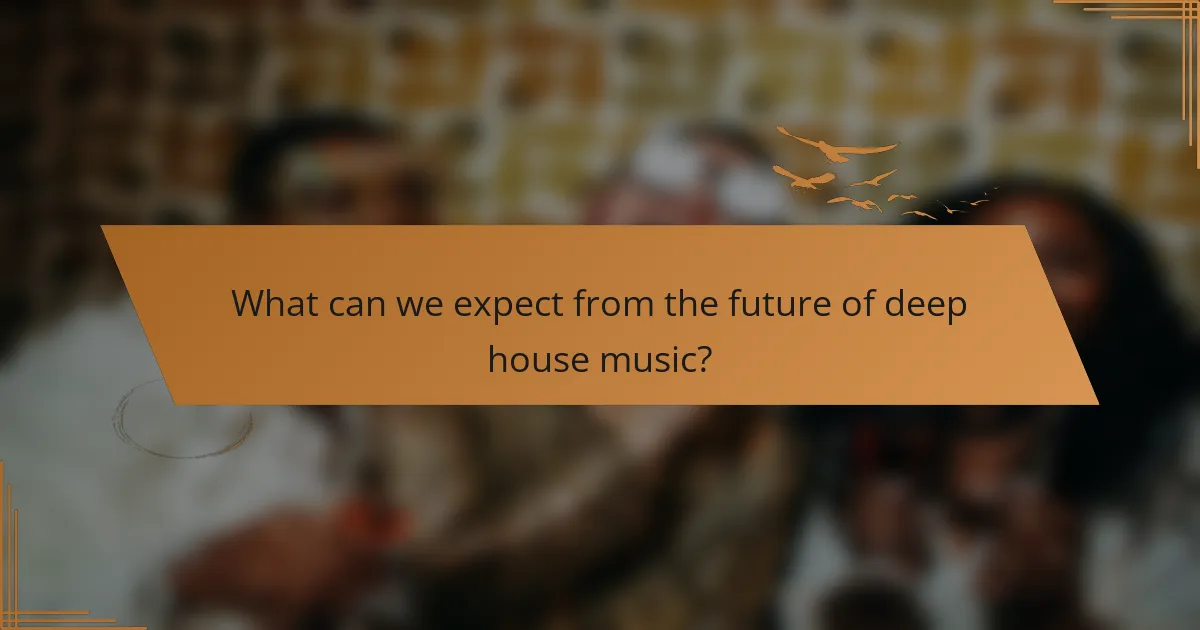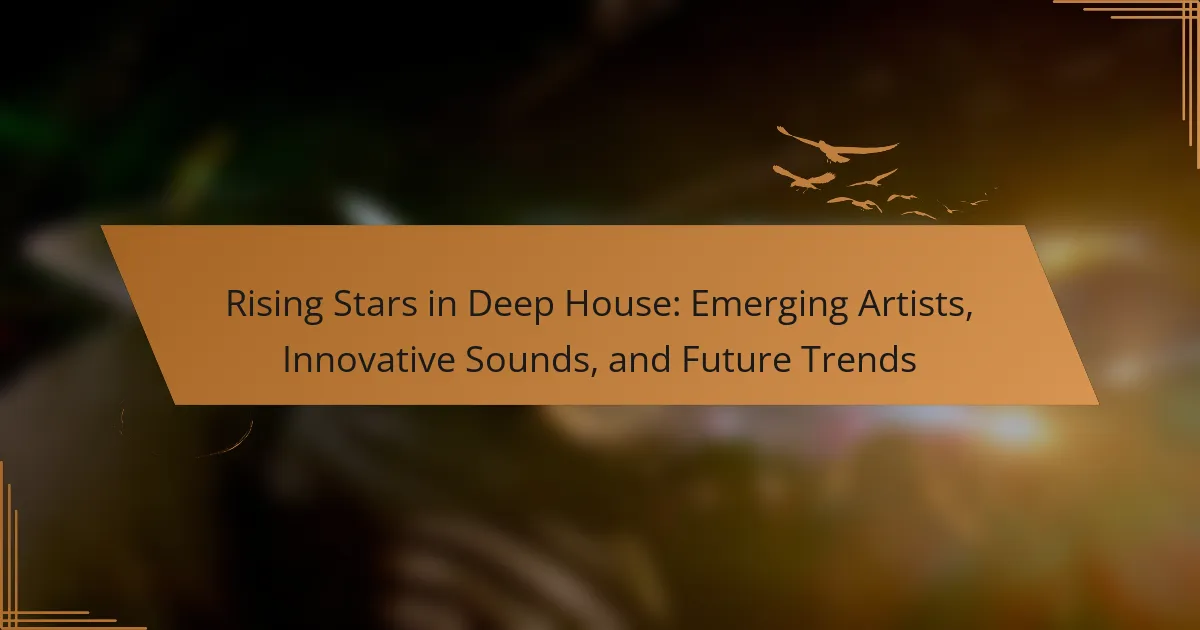Rising stars in deep house music are characterized by their unique sounds, innovative production techniques, and strong online presence. These emerging artists often blend various genres, creating fresh interpretations of deep house that feature intricate melodies and deep basslines. Notable figures in this scene include DJ Tennis, Ben Böhmer, and Nora En Pure, each contributing distinct styles and gaining popularity through collaborations and performances at major festivals. The future of deep house is poised for further innovation, with artists experimenting with new technologies and blending genres, as well as the potential impact of virtual reality on audience engagement. Overall, the deep house genre is experiencing steady growth, with increasing visibility on streaming platforms and a diverse array of tracks.

What are the key characteristics of rising stars in deep house?
Rising stars in deep house typically exhibit unique sounds, innovative production techniques, and a strong online presence. They often blend various genres, creating a fresh take on deep house. Their music features intricate melodies and deep basslines, appealing to diverse audiences. Many rising stars collaborate with established artists, enhancing their visibility. They frequently engage with fans through social media platforms. Emerging artists also showcase their work in underground clubs and festivals. This exposure helps them gain traction in the competitive music scene. Their ability to adapt to trends while maintaining authenticity sets them apart.
How do emerging artists redefine the deep house genre?
Emerging artists redefine the deep house genre by incorporating diverse musical influences and innovative production techniques. They blend genres like techno, ambient, and even world music into their deep house tracks. This fusion creates a fresh sound that appeals to a broader audience. Many emerging artists utilize advanced technology and software to experiment with sound design. They often prioritize emotional storytelling in their music, enhancing listener engagement. Collaborations between artists from different backgrounds also contribute to this evolution. These collaborations introduce unique rhythms and melodies into the genre. Overall, emerging artists are pushing the boundaries of deep house, making it more dynamic and accessible.
What innovative sounds are being introduced by these artists?
Emerging artists in deep house are introducing innovative sounds characterized by unique blends of genres. They incorporate elements from ambient, techno, and even world music into their tracks. For instance, artists are utilizing organic instrumentation alongside electronic beats to create a fresh auditory experience. Additionally, some are experimenting with vocal manipulation and layering, giving their music a distinct texture. The use of unconventional time signatures and rhythms is also becoming prevalent. This blend of styles fosters a more immersive listening experience. Such innovations are reshaping the soundscape of deep house music.
How do these new sounds influence the overall deep house scene?
New sounds significantly influence the overall deep house scene by introducing fresh elements and styles. These sounds often incorporate diverse genres, such as jazz, funk, and ambient music. This blending creates a richer auditory experience for listeners. Emerging artists utilize innovative production techniques, pushing the boundaries of traditional deep house. The introduction of unique vocal samples and instrumental layers adds depth to tracks. As a result, the audience’s expectations evolve, demanding more originality. This shift encourages established artists to experiment with their sound. Consequently, the deep house scene becomes more dynamic and continually evolving.
Why is the emergence of new talent significant in deep house music?
The emergence of new talent is significant in deep house music because it fosters innovation and diversity within the genre. New artists bring fresh perspectives and sounds that can reshape existing musical landscapes. This influx of creativity often leads to the development of unique subgenres and styles. For instance, emerging artists like Disclosure and Lane 8 have introduced elements from various musical traditions, enriching the deep house experience. Additionally, new talent often challenges established norms, encouraging growth and evolution in the music scene. Their presence can also attract younger audiences, ensuring the genre’s longevity. Ultimately, the emergence of new talent revitalizes deep house music and keeps it relevant in a rapidly changing industry.
What trends are shaping the future of deep house?
The future of deep house is being shaped by several key trends. One major trend is the incorporation of live instruments into productions. This adds a unique, organic feel to the electronic sound. Another trend is the blending of genres, such as deep house with elements of jazz and ambient music. This fusion creates innovative soundscapes that attract diverse audiences.
Additionally, the rise of technology in music production is influencing deep house. Producers are utilizing advanced software and hardware to create intricate sounds and textures. The growing popularity of streaming platforms is also impacting how deep house music is distributed and consumed. Artists are now reaching global audiences more easily through these platforms.
Furthermore, a focus on sustainability is emerging within the deep house community. Many artists are becoming more conscious of their environmental impact. This includes using eco-friendly materials for merchandise and promoting sustainable practices at events. Overall, these trends indicate a dynamic evolution in the deep house genre.
How does the rise of technology impact emerging artists?
The rise of technology significantly impacts emerging artists by providing accessible tools for creation and distribution. Digital audio workstations enable artists to produce high-quality music from home. Social media platforms allow for direct engagement with audiences, enhancing visibility. Streaming services provide a global reach, increasing potential listener bases. Data analytics tools help artists understand audience preferences and trends. Crowdfunding platforms offer financial support for projects, reducing traditional barriers to entry. Overall, technology democratizes the music industry, empowering emerging artists to thrive.

Who are some notable rising stars in deep house today?
Some notable rising stars in deep house today include DJ Tennis, Anjunadeep’s Ben Böhmer, and Nora En Pure. DJ Tennis is known for his eclectic sound and innovative productions. Ben Böhmer gained recognition with his melodic tracks and live performances. Nora En Pure is celebrated for her unique blend of deep house and melodic elements. These artists are making significant contributions to the genre, showcasing fresh sounds and styles. Their growing popularity is evidenced by their performances at major festivals and increasing streaming numbers.
What are the backgrounds of these emerging artists?
The backgrounds of these emerging artists vary widely. Many artists come from diverse musical traditions. Some have formal training in music theory or performance. Others are self-taught, learning through experimentation and online resources. Cultural influences play a significant role in their sound. Artists often draw inspiration from their local music scenes. Collaborations with established musicians help them gain visibility. Additionally, digital platforms allow them to reach global audiences. This accessibility shapes their artistic development and career trajectories.
How do their influences shape their music style?
Their influences shape their music style by integrating diverse genres and cultural elements. Emerging artists often draw inspiration from house, techno, and even jazz. This blend creates unique soundscapes that resonate with wider audiences. For example, artists like Black Coffee incorporate African rhythms into deep house. Such influences enhance emotional depth and complexity in their tracks. Additionally, collaborations with artists from different genres further diversify their sound. This cross-pollination of styles leads to innovative productions that push the boundaries of deep house. Ultimately, their influences are crucial in defining their musical identity and artistic expression.
What unique attributes set them apart from established artists?
Emerging artists in deep house are distinguished by their innovative soundscapes and experimental approaches. They often blend genres, creating unique fusions that established artists may not explore. Their willingness to embrace new technology and production techniques sets them apart. Many emerging artists prioritize authenticity and personal expression in their music. They frequently engage with their audience through social media, fostering a direct connection. This engagement allows them to receive real-time feedback and adapt their styles accordingly. Emerging artists also tend to collaborate across genres, expanding their creative horizons. Their fresh perspectives challenge conventional norms within the deep house genre.
What are the most popular tracks from these rising stars?
It is not possible to provide a definitive answer to the question about the most popular tracks from rising stars in deep house. The popularity of tracks can vary frequently based on charts, streams, and audience preferences. Specific data regarding current popular tracks requires real-time analytics and updates from music platforms.
How do these tracks reflect current trends in deep house?
Current tracks in deep house showcase a blend of melodic elements and rhythmic complexity. They often incorporate organic instrumentation, which aligns with the trend toward a more natural sound. Artists increasingly utilize vocal samples, enhancing emotional depth in their music. The integration of technology, such as AI-generated sounds, reflects innovation in production techniques. Additionally, collaborations between genres are becoming more common, creating diverse soundscapes. These tracks also emphasize a slower tempo, resonating with listeners seeking a relaxed vibe. Overall, the evolution of deep house is marked by a fusion of traditional and contemporary influences.
What makes these tracks resonate with audiences?
Tracks resonate with audiences due to their emotional depth and relatable themes. The combination of captivating melodies and rhythmic beats engages listeners. Innovative production techniques create unique soundscapes that stand out. Artists often incorporate personal experiences, making the music more authentic. The use of familiar samples can evoke nostalgia and connection. Additionally, the community aspect of deep house fosters shared experiences at events. Research indicates that emotional engagement in music enhances listener enjoyment and retention. This connection drives audience loyalty and repeated listens.

What can we expect from the future of deep house music?
The future of deep house music is likely to see increased innovation in sound production. Emerging artists are experimenting with new technologies and genres. This includes blending deep house with elements from other electronic music styles. The use of artificial intelligence in music creation is gaining traction. Collaborations between different genres will likely become more common. Additionally, the rise of virtual reality experiences could redefine how audiences engage with deep house. Data from industry reports indicate a steady growth in deep house popularity globally. Streaming platforms are also showcasing more diverse deep house tracks. This suggests a promising future for the genre.
How will emerging artists influence the evolution of deep house?
Emerging artists will significantly influence the evolution of deep house by introducing fresh sounds and innovative techniques. These artists often experiment with diverse genres, blending elements from techno, jazz, and ambient music. This fusion creates unique tracks that push the boundaries of traditional deep house. Additionally, emerging artists utilize modern technology and production tools, which allows for greater creativity and experimentation. They often engage with their audience through social media, fostering a community that values new ideas and collaborations. This interaction encourages a continuous cycle of innovation within the genre. As a result, the sound of deep house is likely to evolve, reflecting these new influences and trends.
What potential collaborations might we see in the future?
Future collaborations in deep house may include emerging artists teaming up with established producers. This trend reflects the genre’s evolution and the blending of innovative sounds. Notable collaborations could involve artists like Anjunadeep’s rising stars partnering with veterans from labels like Defected. These alliances can enhance creativity and introduce fresh perspectives to the genre. Additionally, cross-genre collaborations with pop or electronic artists may become more prevalent. This fusion can attract wider audiences and expand the deep house fan base. As the scene grows, expect collaborations that push boundaries and redefine soundscapes in deep house music.
How are cultural shifts impacting deep house music trends?
Cultural shifts are significantly influencing deep house music trends. The rise of diverse musical influences is reshaping deep house sounds. Genres like hip-hop, R&B, and global music are being integrated into deep house. This fusion creates a more eclectic sound that attracts wider audiences. Additionally, social media platforms are facilitating the discovery of new artists. Artists are leveraging these platforms to showcase innovative sounds. The growing emphasis on inclusivity is also evident in the deep house scene. Events and festivals are increasingly promoting diverse lineups. These cultural changes are driving the evolution of deep house music.
What are best practices for supporting rising stars in deep house?
To support rising stars in deep house, it’s essential to provide platforms for exposure. Organizing local events or showcases can help artists reach new audiences. Collaborating with established artists can also enhance their visibility. Utilizing social media effectively is crucial for building a fanbase. Engaging with fans through live streams or Q&A sessions fosters community. Offering mentorship from industry veterans can guide their development. Additionally, promoting their music on streaming platforms increases accessibility. Providing resources for marketing and branding can further empower these artists.
How can listeners discover and promote new talent effectively?
Listeners can discover and promote new talent effectively by utilizing various platforms and social media. Streaming services like Spotify and SoundCloud often feature new artists. These platforms have algorithms that suggest emerging talent based on listening habits. Engaging with music blogs and online communities can also reveal hidden gems. Many blogs focus on niche genres, including deep house. Attending local music events and festivals showcases upcoming artists in person. Social media platforms like Instagram and TikTok allow listeners to share and promote their favorite new artists. Sharing music on these platforms can increase an artist’s visibility. Collaborating with influencers can further amplify reach. Research indicates that social media engagement significantly boosts an artist’s growth and audience reach.
What platforms are most effective for emerging artists to reach audiences?
Social media platforms are most effective for emerging artists to reach audiences. These platforms include Instagram, TikTok, and Facebook. Instagram allows artists to showcase their visual content and engage with followers. TikTok’s algorithm promotes music discovery through short videos. Facebook offers community-building features and event promotion. Streaming services like Spotify and SoundCloud are also vital for music distribution. According to a 2021 report by the International Federation of the Phonographic Industry, 70% of music discovery happens on social media. This statistic highlights the importance of these platforms for emerging artists.
Rising stars in deep house represent a new wave of artists characterized by innovative sounds, genre-blending techniques, and strong online engagement. This article examines their unique attributes, the impact of technology on their music production, and how they are redefining the deep house genre. It also highlights notable emerging artists, explores current trends shaping the scene, and discusses the significance of new talent in promoting diversity and creativity within deep house music. Additionally, the article outlines best practices for supporting these artists and effective methods for listeners to discover and promote new talent.
